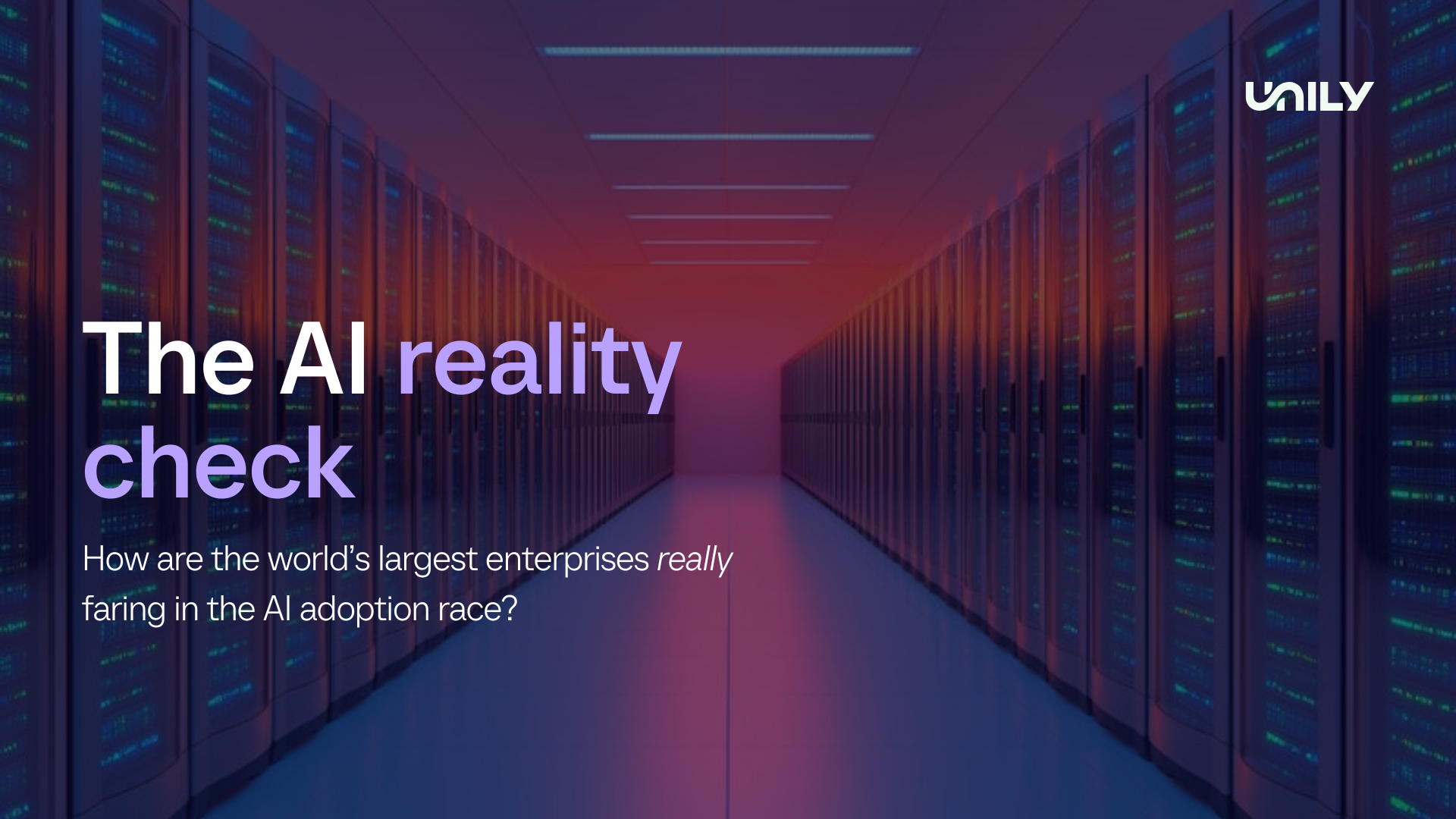
Key Insights
- For many AI represented a false start, with as much as 52% of employees reporting that their organization has no known AI policy
- In the absence of clear, thoughtful AI strategies a two-speed workforce is emerging where 32% of employees have never used AI tooling at work
- Weaving a new workplace is critical as 56% of employees say they would use AI tooling more were it better integrated into their existing workflows
An opportunity to fix the false start we’ve seen for Enterprise AI
Unily’s latest digital workplace research indicates that a lack of AI policy has been to blame for paralyzing enterprise agility. The absence of clear, actionable AI governance and frameworks is leading to slow adoption, while significant awareness gaps are causing confusion in the workplace. Limited direction leading to hesitation is combined with the rise of shadow IT, and the use of unsanctioned, point solutions.
The once promised panacea of AI has failed to materialize across many enterprises, but this is a time for speed and clarity to combat ambivalence in the workforce. Unily’s latest research report ‘The AI Reality Check’, shows that only a fifth of employees see AI as a ‘must have’ for business competition. This misunderstanding tells us that we haven’t adequately connected the vast potential of AI to day-to-day operations, reflected in the fact that 52% of respondents say their company has no known AI policy.
Looking at policy paralysis in more detail, we can see that 70% of organizations are currently operating without proper AI policies with 18% saying that they only have vague or informal equivalents. This policy vacuum is more than just a missed opportunity for progressive business, it is an oversight carrying tangible risk. Lack of clarity is causing hesitation, detrimental to driving forward positive results. Furthermore, employees are taking matters into their own hands by using shadow IT tooling to get their job done well – with many exposing the enterprise to data breaches and security risks.
Reflecting on the outcomes of this Unily research, Chris Ciauri said...
"The findings paint a vivid picture of the challenges and opportunities that lie ahead. The gap between AI leaders and laggards is growing, the stakes couldn’t be higher. Enterprises that act with speed and decisiveness today will be the performance champions of tomorrow."
Chris Ciauri - CEO, Unily
It's time to sync a diverging two-speed workforce
We’re seeing isolated examples of what could be achieved as self-directed power users make productivity gains in small pockets of enterprise, but it’s time the rest of the business caught up. While some may be making moves with AI, the disparity is causing uneven performance and fragmentation across the business. Paralyzed by uncertainty and caution, AI-resistant workers are far removed from AI’s potential. This is driving inefficiencies and fostering a sense of complacency as teams operate at differing speeds.
This friction at the intersection of vastly different swim lanes could be eased with some simple steps. By offering clarity around the advantages of AI, leaders can align workforces around this technology and its benefits. Clear governance around AI usage will also alleviate confusion. Without this, there will be far-reaching implications for competitive edge in an evolved market as AI-laggards struggle to keep up with unified, AI-enabled teams. High performers are also gravitating towards enterprises further along the AI maturity curve, and without swift action slower, less innovative organizations will simply get left behind.
The risks of falling behind are grave
As AI revolutionizes markets, the stakes are existential – and Unily’s research highlights that AI leaders are realizing value that their competitors simply aren’t. There are competitive costs not only around deals won, but in terms of enterprise capability that’s held back from reaching its fullest potential. Complacency abounds and misunderstanding is commonplace when it comes to AI, but the risk of inaction could mean AI laggards are sleepwalking into oblivion.
Poor communication is reflected in this research as only 14% of respondents believe their organization is ahead of the curve with 26% having no clue what their company is doing with AI, and in 2025 – that’s quite something. Many employees feel they’re losing out to AI-enabled competitors and that a lack of adoption is giving them a disadvantage against incumbents. Recovery from the implications of inaction will only get more difficult as time goes on.

Get the AI Reality Check Report
Why organizations are struggling to seize the opportunity
It’s clear from Unily’s research that there is a wider issue afoot. Large enterprise has a hard time adapting to change. More specifically, struggles to adopt agility in the face of technological opportunity. Lack of governance is building significant barriers to adoption, and lack of strategic pivots is leaving enterprises in the wake of their competition.
Outdated, clunky digital workplaces, still prevalent today, are symptomatic of enterprise’s inability to keep up with the pace of change.
Although the temptation may have been to go on a tech stack spending spree, leaders should be careful not to perpetuate the very problems they’re trying to resolve. Without the appropriate governance and access to relevant information, AI tooling alone will add to the growing digital noise and further increase the number of employees who feel overwhelmed by too many apps or tools. AI adoption has been slow to take off, but in the race for progress the cost of falling behind could be high.
The future could be bright, but only if leaders act now
Unily’s research highlights that it’s not all doom and gloom. The secret sauce? Your employees. They see AI as a solution to the velocity drains that have been dogging many industries.
People recognize the transformative potential of this new frontier in cutting through the complexity, streamlining operations, and enhancing the overall employee experience. With 36% of employees seeing the potential for AI to accelerate decision-making speed, tapping into the power of cultural change could make the difference.
Cultural change alone won’t provide the answer, these initiatives must be embarked upon in tandem with integrations. By embedding AI tooling across existing workflow, weaving it through processes and tooling, AI can form part of a broader, integrated shift; one that combines maturity of culture with maturity of infrastructure. As our AI in The Workplace guide pointed out, these two factors cannot exist in a vacuum, they must work together in harmony.
The hallmarks of AI-enabled leaders
As this flagship research from Unily points out, enterprises must respond with agility, facing cultural and tech-stack challenges head-on if they’re going to set themselves apart as AI leaders. With decisive action, strategic clarity, and cultural alignment organizations will unlock the ability to thrive in the AI era.
Get started. Get your personalized demo.
Discover how Unily could transform organizational velocity at your organization.

As part of the Product Marketing team, Aislinn helps drive understanding of our product for Unily’s customers, people, and market. With a keen focus on Comms and CMS, Aislinn is responsible for shaping product marketing campaigns for key new iterations of the product. She helps to empower teams, optimizes product exposure across key touchpoints in the market, and nurtures significant relationships.